By Jeffrey Ressner
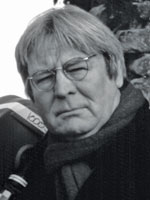 A prison drama with the dramatic intensity of a horror movie, Alan Parker’s Midnight Express has its fill of gut-wrenching, heart-stopping scenes. Loosely based on a true story, the 1978 film follows young Billy Hayes, who was arrested in Turkey for attempting to smuggle out two kilos of hashish and underwent years of abuse in confinement before successfully mounting a daring escape. Adapted from Hayes’ memoirs by then-unknown screenwriter Oliver Stone, the film was Parker’s second feature after directing several BBC shorts and more than 500 commercials before his 1976 big-screen debut with Bugsy Malone. Budgeted at about $2.3 million, Midnight Express ultimately made $100 million in worldwide box office, and earned Parker a DGA and Oscar nomination for best director. Starring Brad Davis as Hayes, the movie was filled with several highly emotional moments, none more shocking than this fight scene in which a duplicitous Turkish convict (Paolo Bonacelli) snitches on dissolute inmate Max (John Hurt), causing Hayes to go ballistic. The violence swiftly escalates far beyond a vicious jailhouse pummeling, and even today the sequence hasn’t lost any of its bite. “When I saw this scene for the first time with a paying audience, I remember a woman ran out and vomited in the lobby because she was so appalled,” said Parker. “What flickers up there on a screen for us as filmmakers is an illusion, a thousand shots with fifty thousand Scotch tape joins. The effect on audiences is something else—to them, it’s real.”
A prison drama with the dramatic intensity of a horror movie, Alan Parker’s Midnight Express has its fill of gut-wrenching, heart-stopping scenes. Loosely based on a true story, the 1978 film follows young Billy Hayes, who was arrested in Turkey for attempting to smuggle out two kilos of hashish and underwent years of abuse in confinement before successfully mounting a daring escape. Adapted from Hayes’ memoirs by then-unknown screenwriter Oliver Stone, the film was Parker’s second feature after directing several BBC shorts and more than 500 commercials before his 1976 big-screen debut with Bugsy Malone. Budgeted at about $2.3 million, Midnight Express ultimately made $100 million in worldwide box office, and earned Parker a DGA and Oscar nomination for best director. Starring Brad Davis as Hayes, the movie was filled with several highly emotional moments, none more shocking than this fight scene in which a duplicitous Turkish convict (Paolo Bonacelli) snitches on dissolute inmate Max (John Hurt), causing Hayes to go ballistic. The violence swiftly escalates far beyond a vicious jailhouse pummeling, and even today the sequence hasn’t lost any of its bite. “When I saw this scene for the first time with a paying audience, I remember a woman ran out and vomited in the lobby because she was so appalled,” said Parker. “What flickers up there on a screen for us as filmmakers is an illusion, a thousand shots with fifty thousand Scotch tape joins. The effect on audiences is something else—to them, it’s real.”

We weren’t allowed to use the original Sagmalcilar prison in Istanbul, so—like all of the prison scenes—this was shot in Malta at a 19th-century British army fort. Most rooms were too small to fit our cameras and a crew inside, so we built this communal area called a kogus within the fort’s courtyard, with balconies and staircases going in all directions. John Hurt, shown here with his hands in the air, decided not to shower for six weeks in order to stay in character. Needless to say, we avoided him after we finished shooting each day and retired to the bar at the Hilton. He smelled a bit unpleasant, but he’s a consummate actor.
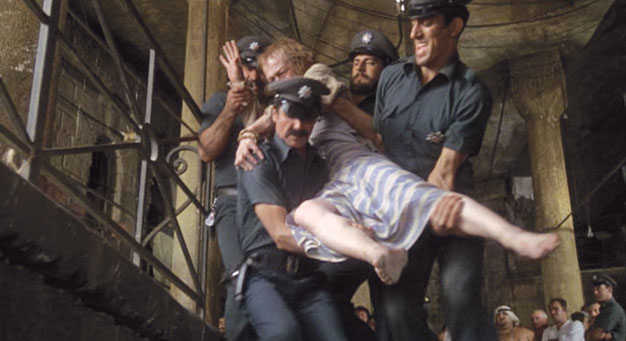
At least 60 percent of the film was shot handheld by cameraman Michael Seresin using an Arriflex BL 35 mm camera and fast Zeiss lenses. The Arri BL is pretty heavy and it’s not meant to be thrown around the way we did, but it allowed us to get into tight corners and shoot more dramatic angles. This shot was done from the bottom of the stairs, and then John’s hand gets trodden on by a guard as he clings to the rail, which was very unpleasant for him. Seresin and I went back several years, probably to 1970 when we started working together on commercials. I’ve always said, ‘You don’t just want someone who’s good at what they do; you need to get on with them, especially if you’re a long way from home.’
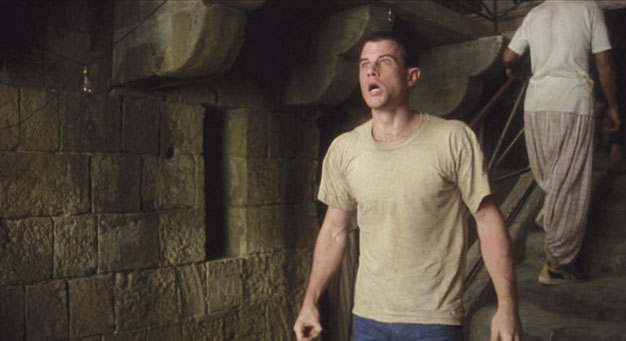
I don’t do storyboards, but I do a lot of drawings and scribbling and layouts of how things might edit together. The actual fight was choreographed down to the tiniest details. At this particular moment in time, we see the character of Billy really starting to lose his mind. He thought he was going to be jailed for four years, but that’s been transmuted into life imprisonment, so he’s frustrated. He’s seen his close prison friend carried away and harbors real hatred for this character Rifki (Paolo Bonacelli), who snitched on his friend. So this is the exact moment when Billy loses control and takes out all his frustrations with this brutal attack. You can tell Brad lived out this part—before each take, he did handstands, push-ups, and peed into a metal bucket.
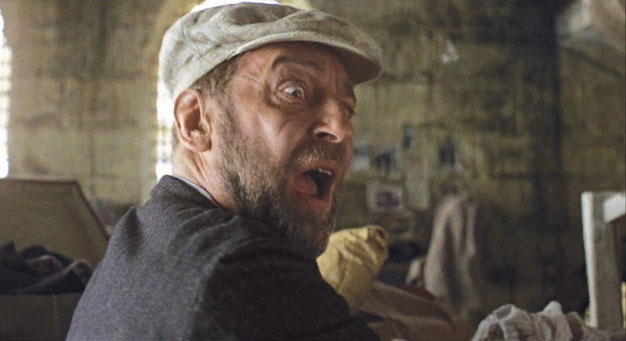
This is a simple reaction shot of Paolo, who had done very good work in Italy for Pasolini and others. I cast the film mostly in Italy, Greece, and London—every Greek Cypriot waiter wanted to be in the film. We weren’t allowed to shoot in Turkey, so there was a combination of a lot of different nationalities. I built those windows in the background specially, so that there was always sunlight in every frame, really. The whole purpose of building that kogus our way with those specific window shapes was so they’d eventually figure in every shot, which you wouldn’t get in the traditional architecture of a prison.
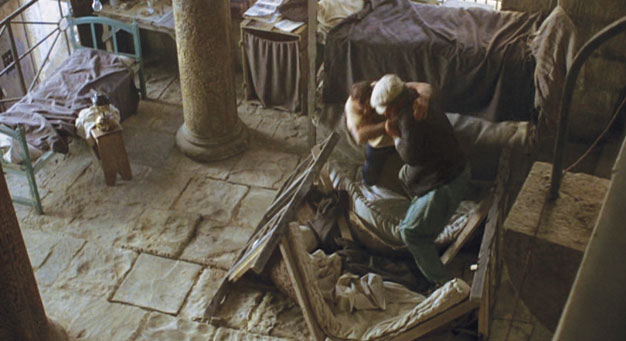
This was a shot to establish the geography of the situation. The room we built had stone staircases and iron balconies from the exterior of the original fort that became the internal structure of this main communal area. Having these balconies and staircases allowed us to do more interesting angles without having to resort to things like cranes. I don’t think I used a crane for the entire film. This shot from the top of the staircase saw Billy leap up and attack Rifki, and then the two men smash into a breakaway bunk bed, which had to be rigged along with the wash basins that get destroyed later on.
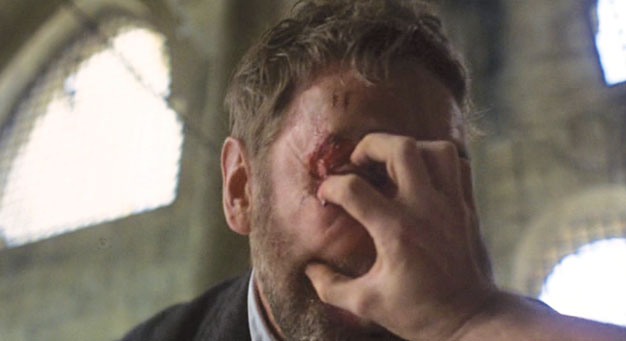
This marks the first real, bloody, hand-to-hand contact—we wanted the scene to be as brutal as possible, and not just fisticuffs. Of course, this is one of those things that look a lot nastier than it really was, but looking at this now it still looks pretty horrendous. We shot mostly six-day weeks for the entire 53-day schedule, and shooting was incredibly tight. The Sunday before the fight, I walked through and choreographed the whole sequence with Roy Scammell, a stunt coordinator who was Malcolm McDowell’s double in A Clockwork Orange. Here, the eye-gouging effect was quite easily achieved. The low, acute angle dramatizes the action that we augmented with fake blood and loose skin.
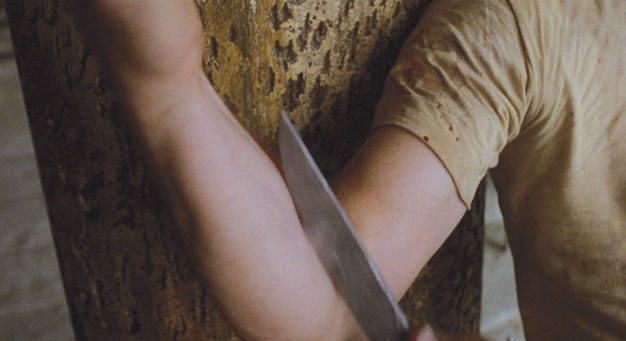
We used two main props for this entire sequence—the tongue that was used later on, and this knife which we brought over from England. It’s really just a conventional stunt weapon with a hollow blade and a rubber bulb filled with fake blood, so when you stroke the blade across an arm you get a line that looks like a very nasty cut. It’s incredibly effective on film, and it worked so well on the first take that I didn’t have to shoot it again. As most directors know, you can spend quite an enormous amount of time on a simple shot like this and it never seems to work, but then there are other days when the most complicated things are the easiest to shoot.
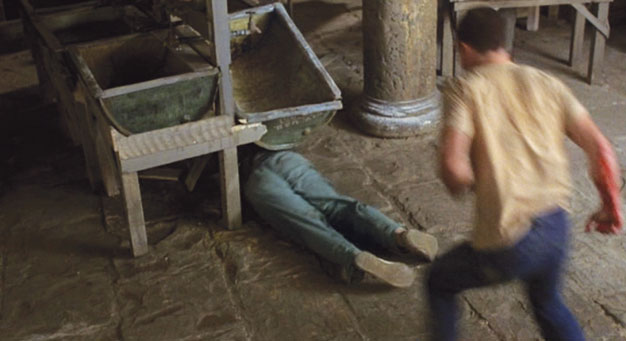
Brad was a fearless actor, and he was very physical, especially in this scene. He was a very vulnerable young man, but was incredibly loyal to me as a director and only ever wanted to please me. We had two stuntmen on call during this entire sequence, but they were hardly noticeable since Brad did most of his own things. Paolo was also very brave, but he wasn’t a physical actor. This is probably a stuntman [for Paolo], but it’s difficult to tell in the final film because we did a lot of cuts in this scene. Although it was handheld, we didn’t shoot the fight as one continuous take—it was shot from many angles, and then the editor, Gerry Hambling, brilliantly cut it together.
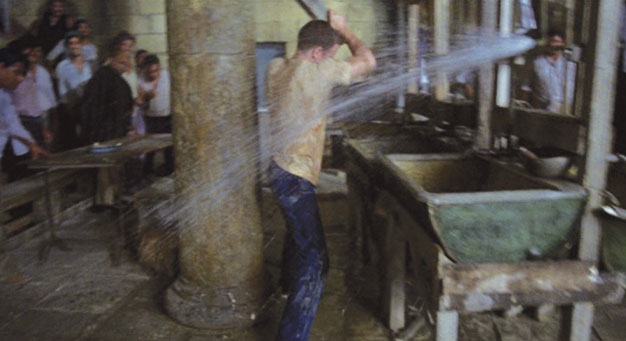
We rigged all the pipes and things so they would break much easier than the real thing. Once we choreographed the scene, we dismantled the wash area, then rebuilt and rigged it so it would spurt water the way we wanted. But Brad was literally so out of control we never knew quite what he would hit, including Paolo. Continuity was a bit of a problem, because every time he’d smash the troughs the water would come from another place and his clothes would get wet differently, so we needed lots of clothes for him to change into. The most important thing is the energy of the scene; that way if you get yourself into trouble, you can always get out of it in regards to continuity.
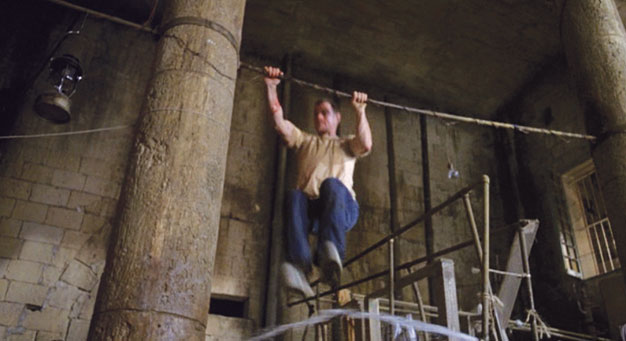
Billy has lost Rifki underneath these basins and pipes, so he has to swing from the pipes down to the floor below. A great deal of this shot was [camera operator] John Stanier and I lying on our backs with the handheld camera as low as possible. When I say handheld, it wasn’t the kind of wobbly scope most people associate with the technique. John was incredibly strong and he’d hold the camera very steady. It was an alternative to using a dolly or tripod, except we could get very low very quickly without bringing in all the paraphernalia, which meant we could shoot much faster. With Brad, who is suddenly not really acting but actually going a little crazy, we had to be fast on our feet. We couldn’t stop everything and say, ‘Oh, we’re going to rig up a dolly now.’
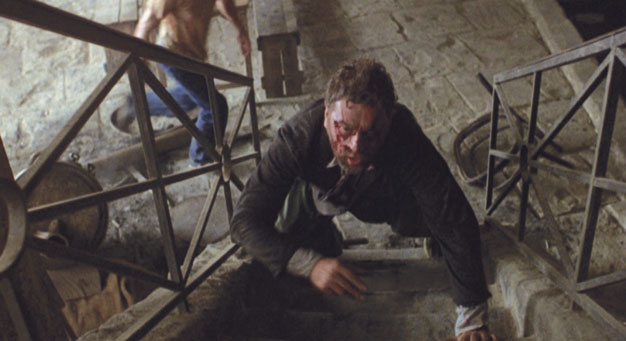
As Rifki escapes from the washing area he tries to climb the stairs and Billy jumps from the troughs right onto him. We had given Paolo false teeth and a contact lens that looked like a glass eye, and I was always concerned he might get hurt during a fight scene, that something bad might happen to that glass eye. So we had to be very careful with him. This was a real stone staircase that Paolo is climbing up, trying to escape Brad. The stairs on this kogus set were designed in such a way that every single angle you looked at gave you a great shot. And being handheld gave us the ability to shoot faster and braver with more dramatic angles, all of which could then be cut together in an intricate manner.
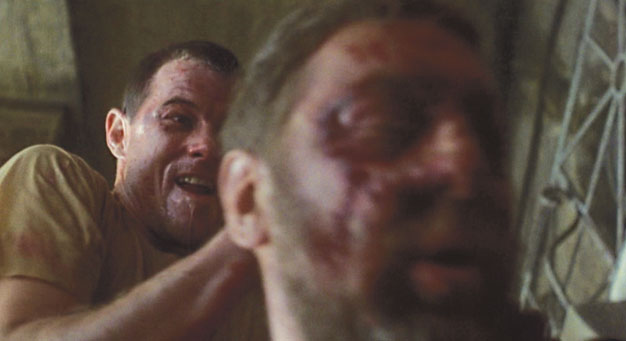
In this shot, Billy is smashing Rifki’s head into the stairs and right after that bites off Rifki’s tongue. John and I were so close we thought our own heads would get hit. Fortunately, Geoffrey Kirkland, the production designer, rigged one of the steps with sponge-like material so Paolo wouldn’t get a headache as Brad was banging his skull. I used music throughout the entire fight sequence, but it’s most relevant here. I had bought a lot of homemade Turkish cassettes that had strange, melodramatic radio plays being acted out to music. So when we did the final sound mix using Giorgio Moroder’s score, I put this weird music on and kept bringing the sound in and out. It added quite strongly to the whole atmosphere of alienation, and I brought it in just as he’s biting down on the tongue.

The prop people gave me a plate of offal, and I picked what looked like the juiciest piece, which happened to be a pig’s tongue. The biting and spitting out of Rifki’s tongue was so intense and John and I were so engrossed shooting it, that when I yelled ‘Cut,’ I looked up and noticed the rest of the cast and crew were all so put off by the biting and the bloody brutality of it that they’d retreated to the back of the set. I shot this particular bit of Brad spitting out the tongue in slow motion, because if we had shot it in real time you’d never have seen it and the actual tongue wouldn’t have registered—you’d have thought he was just spitting out blood.
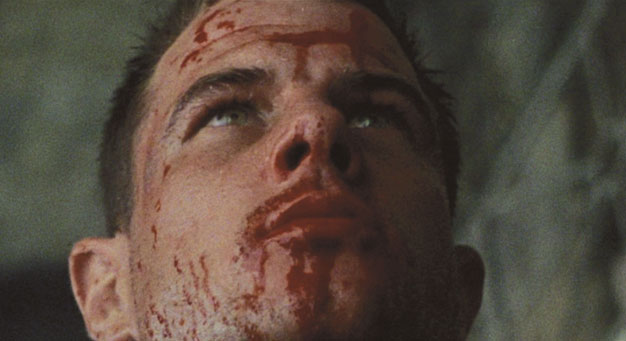
I had to push Brad as far as he could go as an actor, and as we both pushed everything dramatically to its extreme, there were times when maybe I leaned on him too much. The fight scene in the script ends with the words, ‘He looks like a savage. No longer Billy Hayes.’ And that’s what we tried to capture with this particular frame: that maniacal look. For this final shot, I drowned out all real sounds and had the Moroder score underneath while I brought this surreal melodramatic radio music in and out with the fader. You don’t hear Rifki saying anything, you just hear these weird Istanbul sounds and this silent scream. It’s what makes the moment eerie and kind of special.’